In the early nineties, both the Nintendo Game Boy and The Simpsons were incredibly hot property. The Game Boy was well on its way to becoming a phenomenon, and The Simpsons had already made it there – appearing on billboards, television commercial and merchandise everywhere you would look. It came as little surprise then when a Game Boy title based on the TV series was announced in 1991. This would be a follow-up to the interesting Bart Vs. The Space Mutants which, despite some awkward controls, had some innovative gameplay that fused platforming and puzzle elements. So there were high hopes for this new title.
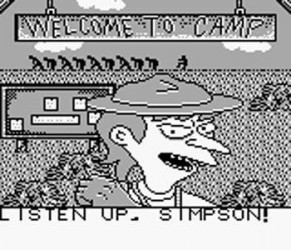 Unsurprisingly however, gameplay for the Game Boy title was simplified somewhat, and Bart Simpson’s Escape from Camp Deadly became a straight-forward platform title. The idea of the game is very similar to that of the Camp Krusty episode of the television series – where Bart and Lisa stay at a terrible summer camp – although the game actually came before that episode. This time, the camp is run by Ironfist Burns – the nephew of Mr Burns – who hates children and wants them all to suffer at his camp. This is made even worse by the fact that he has hired all of the school bullies to help run the camp – and Bart and Lisa understandably want to escape. As you can tell, the developers wanted to shoe-horn in a lot of familiar Simpsons characters, but only into a game based loosely on the series.
Unsurprisingly however, gameplay for the Game Boy title was simplified somewhat, and Bart Simpson’s Escape from Camp Deadly became a straight-forward platform title. The idea of the game is very similar to that of the Camp Krusty episode of the television series – where Bart and Lisa stay at a terrible summer camp – although the game actually came before that episode. This time, the camp is run by Ironfist Burns – the nephew of Mr Burns – who hates children and wants them all to suffer at his camp. This is made even worse by the fact that he has hired all of the school bullies to help run the camp – and Bart and Lisa understandably want to escape. As you can tell, the developers wanted to shoe-horn in a lot of familiar Simpsons characters, but only into a game based loosely on the series.
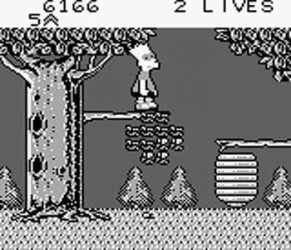 The levels begin by replicating day-to-day summer camp life – albeit an evil summer camp. We start with a wicked game of capture the flag, where Bart must climb trees, jump over rivers and avoid swarms of killer bees – all whilst using his trusty spit wads (a lovely projectile weapon) to dispatch any camp counsellors (bullies) who come his way. Occasionally the player will re-unite with Lisa (who is unplayable in-game), who will provide a different weapon for Bart to make use of. One example of this is the Boomerang, which does exactly what you would expect. Even more helpfully, at one point she will provide you with a Beekeeper’s outfit, which thankfully helps you avoid damage from pesky bees.
The levels begin by replicating day-to-day summer camp life – albeit an evil summer camp. We start with a wicked game of capture the flag, where Bart must climb trees, jump over rivers and avoid swarms of killer bees – all whilst using his trusty spit wads (a lovely projectile weapon) to dispatch any camp counsellors (bullies) who come his way. Occasionally the player will re-unite with Lisa (who is unplayable in-game), who will provide a different weapon for Bart to make use of. One example of this is the Boomerang, which does exactly what you would expect. Even more helpfully, at one point she will provide you with a Beekeeper’s outfit, which thankfully helps you avoid damage from pesky bees.
This variety in weapons is interesting, mainly for the reason that the bosses you will encounter in the camp are all given cryptic names. These names all give the player hints on how to defeat the enemy, for example, Blindside Bill can only take damage when hit in the back. Or Rebound Rodney needs to be defeated by a returning Boomerang. None of these names are too cryptic or challenging, but it is a nice touch that shows that a little thought has gone into the bosses, rather than them all being dispatched via the exact same method. Sadly this same inventiveness doesn’t also apply to the stage design.
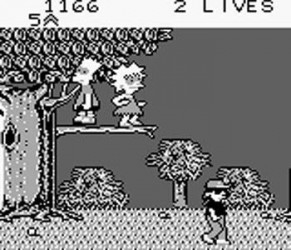 As we move through the game, we pass through two separate lunch hall stages, more forest-based capture the flag, and we move to Mount Deadly as the pair try to go over the mountain to escape from the camp for good. The action across all of these levels remains more or less unchanged though, the same jumping, firing, climbing is featured across all of the stages, without much variety in the gameplay. This carries all the way through the game, even through the Power Station finale (these Burns boys love power plants), where the final showdown takes place.
As we move through the game, we pass through two separate lunch hall stages, more forest-based capture the flag, and we move to Mount Deadly as the pair try to go over the mountain to escape from the camp for good. The action across all of these levels remains more or less unchanged though, the same jumping, firing, climbing is featured across all of the stages, without much variety in the gameplay. This carries all the way through the game, even through the Power Station finale (these Burns boys love power plants), where the final showdown takes place.
None of these levels share the cartoon joy and life that any Simpsons cartoon possesses – not helped by the lack of colour on the Game Boy – the stages all tend to blend together, with the gameplay staying more or less the same from one to the next. There are only six stages all told, and as such the game is rather short. None of the levels are particularly lengthy – it is only the difficulty of the game, coupled with the fact that there is no password system at all, that give the game any real length. And unfortunately the difficulty of the title doesn’t come through challenging gameplay, as a gamer would like, but through the limitations of the Game Boy and by the controls.
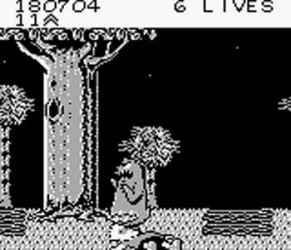 This is largely due to the large size of the on-screen sprites, coupled with the slightly floaty jumping controls. Judging jumps correctly is difficult because Bart jumps in a somewhat unpredictable manner – the jumping control isn’t precise or responsive enough – so you will repeatedly find yourself drowning or landing on some bees, and having to restart the stage. Because the Game Boy screen is so small, and the fact that such a large number of bullies and killer bees are constantly appearing on-screen to attack you, the player has little time to react. The large sprites take up a big portion of the screen, so when an enemy does appear, they are on top of you within the blink of an eye. There sometimes just isn’t enough space on the screen to manoeuvre in time, or see your enemy quickly enough to shoot them.
This is largely due to the large size of the on-screen sprites, coupled with the slightly floaty jumping controls. Judging jumps correctly is difficult because Bart jumps in a somewhat unpredictable manner – the jumping control isn’t precise or responsive enough – so you will repeatedly find yourself drowning or landing on some bees, and having to restart the stage. Because the Game Boy screen is so small, and the fact that such a large number of bullies and killer bees are constantly appearing on-screen to attack you, the player has little time to react. The large sprites take up a big portion of the screen, so when an enemy does appear, they are on top of you within the blink of an eye. There sometimes just isn’t enough space on the screen to manoeuvre in time, or see your enemy quickly enough to shoot them.
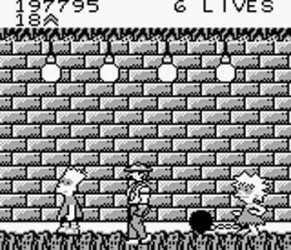 But that isn’t to say that the large sprites are purely a problem. They are detailed and nicely animated for what is a relatively early Game Boy title, and the characters from the television series are clearly recognisable to players. The backgrounds are also detailed and help set the scene, although sometimes they are so busy that they can detract from and interfere with the action – making it more difficult to discern the lines between enemy and background elements. This only adds to the already frustrating flaws that hinder your progress through the title. A few digitised sound effects and some fairly inconsequential music does little to make the sound design leave a lasting impression.
But that isn’t to say that the large sprites are purely a problem. They are detailed and nicely animated for what is a relatively early Game Boy title, and the characters from the television series are clearly recognisable to players. The backgrounds are also detailed and help set the scene, although sometimes they are so busy that they can detract from and interfere with the action – making it more difficult to discern the lines between enemy and background elements. This only adds to the already frustrating flaws that hinder your progress through the title. A few digitised sound effects and some fairly inconsequential music does little to make the sound design leave a lasting impression.
And so it is with the main game overall – the level design doesn’t resonate with fans of the television series enough to win them over and the gameplay isn’t tight enough, with enough variety, to grab the attention of platforming fans. It tries to shoehorn in many Simpsons characters and the title is a good-looking game for the time it was released, but the gameplay just becomes too frustrating due to the poor controls and other game design faults. After Bart Vs. The Space Mutants was inventive and genre-blending, Camp Deadly seemed to lack in ambition in comparison. Unfortunately this was just the start of this problem, as Simpsons games struggled to hit the mark for years after, with a slew of poor or mediocre titles on the next few console generations. The Simpsons games have always struggled to live up to the source material.
The God is a Geek Retro Corner will return on the first Friday of next month. You can see previous entries into the GodisaGeek Retro Corner by clicking here.
Robin Parker
If I'm not playing on a good Adventure Game - still longing for the long-past Golden Age of the genre, when Lucasarts and Sierra ruled supreme - you might find me searching for a local arcade, in the hopes that it still houses titles such as Sunset Riders or WindJammers.







